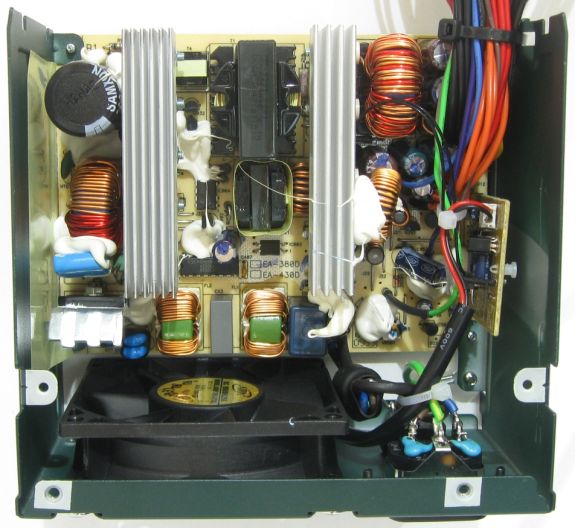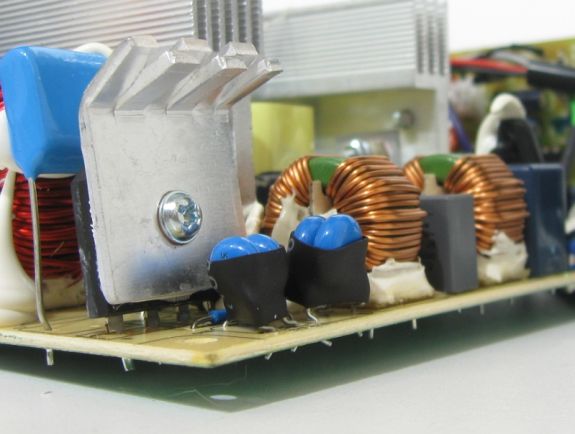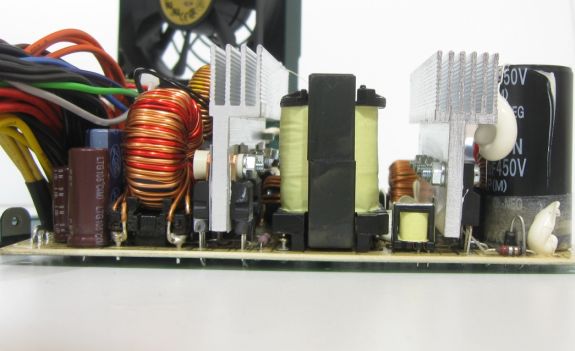Antec EarthWatts EA 380D Green 380W
by Martin Kaffei on October 2, 2010 7:00 PM EST- Posted in
- Cases/Cooling/PSUs
- PSUs
- Green
- Antec
- Earth Watts
- 380W
Internals
After opening the PSU, a well-structured design can be seen with two rather slim heat sinks, which are positioned according to the airflow. Similar to the first EarthWatts models (designed by Seasonic), the heat sinks don’t form a tunnel topology, which means that the airflow isn’t as linear as we have seen elsewhere--i.e. an Arctic Cooling PSU with their thoughtfully positioned air foil. But there is less energy dissipating into heat because of the lower nominal power and higher efficiency and there are large spaces inside where the air is able to circulate. The position of the rectifier bridge with its heatsink and the EMI-filter slightly hinder the airflow.
The IEC-plug is followed by the mains switch, which engages the phase conductor when thrown. Two Y-caps are connected with a protective ground wire, which is securely fixed on the case. Additional glue would be useful to improve mechanical stability. Well-twisted phase and neutral wires are coiled around an additional ferrite core and securely soldered. If wires are not twisted well, the connection could easily break. [Note: The quality in Chinese factories is still fluctuating.]
Two common mode chokes, four Y-caps, and two X-caps follow, with another X-type cap located behind the rectifier bridge; however, a varistor is missing. From this perspective we can see how precisely the chokes are fixed. In the power factor pre-regulator, we find a Samxon capacitor with the model number MXL. The Champion-IC 6800AG regulates the PFC and the main circuit of the PSU. This IC features OCP (Over Current Protection) and short circuit protection and has become popular because of its low-loss controlling.
Since the glue can’t always be positioned accurately, the 12V-choke is stabilised with a socket, which is useful at certain sizes. The costs are higher and the processing is more complicated. This kind of fastening is more likely to be found in high-end models. Sometimes this method is impossible, since the space is limited. The last model with this feature was the Enermax Revolution85+ 850W, where the size of the PFC-choke was the problem. In the OEM sector it is common to fix the components above necessity.
The +12V rail is filtered by Nippon Chemi-Con (KZE) and Ltec (LZG) capacitors, while on the smaller rails a potpourri of Nippon Chemi-Cons, Ltecs, and a single Taicon are used. A metering diode on a heat sink measures the temperature.
The noted build quality continues with a high soldering quality. Most conducting paths are cleanly soldered, but the output cables of the secondary circuit had to be cut so the wires don’t protrude too much under the PCB. Usually the manufacturer should be able to estimate the lengths of the wire when using THT-components. Connections could break if protruding wires are cut off. On the solder points of phase and neutral wires, solder residue can be found because of a very high soldering temperature, but there are no damages visible.














64 Comments
View All Comments
JimmiG - Sunday, October 3, 2010 - link
Very refreshing to see a quality PSU in this segment. The wattage race is really getting out of hand. If someone posts about system crashes or poor performance, and has anything less than a 750W PSU, people instantly tell the person to upgrade the PSU. A week later, the original poster returns, saying the shiny new 1200W PSU did not solve the problems, and the original 550W PSU was more than enough for a 65W dual core CPU and a 100W GPU...Setsunayaki - Sunday, October 3, 2010 - link
True Story,I helped a company a year back switch their internal computers to 10w - sub10w systems for basic things...such as email, work and writing up documentations and analyzing to improving business growth. A 400w supply truly means that I am using 25 - 30w more power on basics...
As far as HD goes, there are laptops which run 720P (though 1080P is the desired resolution) which draw a lot lower amounts of power....
This is why I frown on things like this....like when someone tells me I should buy ATI to save power on graphics to be able to do basic things, I simply wonder..."Why don't enough people who run on basic things buy basic laptops or sub-10w systems?"
The sub-10w systems based on nano-ITX boards also allow a LOT of space to be saved...specially since you wont have tons of towers floating around. I received an email a few weeks ago when they were moving to a new building they managed to put in two boxes, 100 nano iTX systems for their employees to transfer to their new building. As for monitors, that was another story....
mck22 - Sunday, October 3, 2010 - link
I have owned one of these since March and it has functioned without incident.I bought it in a hurry after I found that the cables on the other, more powerful PS I had purchased for a new build for my wife's use were too short to reach the MB's in the Antec 300 case that she had approved of for its cosmetics.
None of the other PS's I had laying around would reach either, so I assumed that an Antec would work. I bought the cheapest available since I had already exceeded my original budget. I have no regrets, which is the best compliment I can make for a PS.
ehume - Sunday, October 3, 2010 - link
This is not a very quiet psu. Or, I should say its predecessor the EA 380 has a noisy fan, especially with a little dust on it. Maybe it unbalances the fan. But even with the dust gone it makes too much noise. In a room full of computers, it is the EA 380 we all hear, and it is not a pleasant sound..Larger fans move more air more quietly than this one does. This was absolutely the last psu I will get that has an 80mm fan.
Christoph Katzer - Sunday, October 3, 2010 - link
Hi,The noise would have had nothing to do with the size of the fan. You'll wonder when you stress a power supply to its limits the fan will always turn louder which is good and necessary for cooling. It always depends on the bearing type in fact. There might have been something wrong with the fan which can unfortunately happen, but a blank statement 80mm fans are bad is very wrong. They are able to cool the PSU internals much more efficient for example. The air goes straight through without being rerouted.
Christoph
strikeback03 - Tuesday, October 5, 2010 - link
I have used several of the older EarthWatts 300-380W PSUs for builds in our lab, in all of them the fans have been essentially silent.METALMORPHASIS - Sunday, October 3, 2010 - link
Antec makes great power supplies. I have 4 of them, and all are going strong after 5 years.theagentsmith - Monday, October 4, 2010 - link
A few years ago I read about how much PSU efficiency can be useful both to save on electricity and the environment, so I began looking for a 80plus certified units that didn't cost an arm and a leg.I found this very EA380W which had stellar reviews, the right size and a reasonable price of about 50 euros.
If they made a 250-300W 80plus model I would have chosen it, because most system doesn't exceed 150W in full load
recidivist - Thursday, October 7, 2010 - link
From p7: "Antec is using an ADDA-fan (AD0812H5-A70GL), which has a ball bearing and a power consumption of 0.25A"The pic of the fan label clearly shows AD0812HS-A70GL. H=High Speed. S=Sleeve Bearing. Fan RPM is thermistor controlled.
Morbid666 - Thursday, October 7, 2010 - link
I've already built about 8 systems for my clients with this PSU (mostly office workstations). for its cheap price you get antec quality, plenty of connectors, all sorts of protection & its whisper quiet. i would reccomend this product to anyone building a reliable cost efficient workstation.